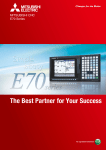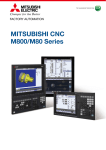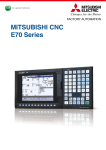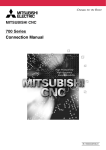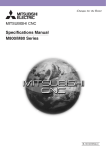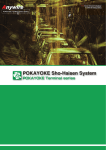Download Mitsubishi Electric M750 Specifications
Transcript
MITSUBISHI CNC M700V Series The Best Partner for Your Success Mitsubishi CNC M700V Series The best machines for top level manufacturing The one and only. Only top level manufacturing can sur vive. Mitsubishi CNC M700V Series is a state-of-the-art model that provides high-speed and high-accuracy machining and advanced control technologies. These Functions are for customers who keep challenging for more production output, with a worldwide recognized machine for today’s globalized industr y. M700VS Series is an integrated control unit and display type. M700V W Series also comes with Windows ®XPe. These two types of Mitsubishi CNC M700V Series support top level manufacturing. [Complete NANO] [5-axis, multi-axis] Controls everything from the CNC’s operation to servo processing with a least command increment of 1nm Controlling multiple axes allows the positioning of the tool center point [High-speed, high-accuracy] [Easy operation] High-quality machining by determining appropriate shapes and avoiding unnecessary deceleration Simple programming system for machining center and lathe [High-speed, high-accuracy] [Customize] High-speed and high-accuracy control of the drive system is achieved by estimating program paths from beginning to end Tools used in developing solutions for control customization M700series V MITSUBISHI CNC The Best Partner for Your Success M700VS and M700VW Series, advanced Mitsubishi CNCs for next-generation machining 1 2 M700series V System Configurations & Product Lines Drive Unit Mitsubishi CNC M700VW Series M700VS Series Multi-hybrid drive unit MDS-DM2 Series M700VWSeries High-performance drive unit MDS-D2/DH2 Series Ultra-compact drive unit with built-in power supply MDS-DJ Series Servo Motor Linear servo motor LM-F Series M700VSSeries MELSOFT Medium-inertia motor HF Series Machine Operation Panel (Tools) Low-inertia motor HF-KP Series Direct drive servo motor TM-RB Series Spindle Motor Rotary detector MBA Series Built-in spindle motor SJ-BG Series SJ-B Series Personal computer+Windows ® NC Designer NC Monitor NC Explorer NC Trainer NC Trainer plus NC Analyzer NC Configurator2 GX Developer NC Maintainer etc. High-performance spindle motor SJ-D Series SJ-V Series Low-inertia and high-speed spindle motor SJ-DL Series SJ-VL Series Tool spindle motor HF-KP Series HF-SP Series Detector for C axis MBE Series From drive units to servo/spindle motors Advanced CNC components for higher performance 3 4 M700series V Technologies Complete Nano Control PLC Axis All operations from program values to servo commands are done in nanometer units. Interpolation is at the nano-unit level even when program commands are in micrometer units. Basic Performance and Functions High-speed architecture Indexing function By setting the number of stations required for the application, the drive automatically sets up equal intervals between each station. Positioning of the axis is only possible by commanding the station number. Drive unit MDS-D2/DH2 M700V Series For higher speed and higher accuracy 1 24 Table 23 22 High-gain control II High-accuracy detector: 16million p/rev 21 9 Speed command fluctuation reduced In complete nano control, the position command calculation fraction of the interpolation calculation is small, so fluctuations in speed command due to the fractions is reduced. This reduces acceleration fluctuations, resulting in finer lines at the time of repeated acceleration/deceleration. Micron system (Our conventional) Complete nano system (M700V Series) Speed Speed Machining Program Processing Speed Decelerator 11 M700V Series 13 14 18 17 16 15 Indexing function with magazine axis PLC axis mixed control Even if a pallet is changed, the axis can always be controlled as an NC axis in the machining area, and as a PLC axis in the setup area, which enables setup of a rotary axis without stopping machining. Speed fluctuation Acceleration rate 135kBPM(Note 1) 168kBPM 12 Servo motor 19 Setup area (Note 2) 5 6 20 Speed fluctuation M700 Series 4 7 8 10 Mitsubishi Electric Factory Automation technologies are condensed into a 64 bit RISC processor and an exclusively developed high speed LSI. The basic CNC functions, built-in PLC and graphic performance are all improved. The M700VS has been downsized with power consumption reduced by 66% compared to our conventional Windows-based control models while maintaining the same performance. Windows®XPe-based M700VW was designed with expandability and stability to enable a higher level of custom functions. 3 Indexing position High-speed optical network Bringing the complete nano world closer to you 2 Z (Note 1) BPM is the number of machining program blocks processed per minute. (Note 2) M720VS’s machining program processing speed is 67.5kBPM. User Macro Processing Performance A’ Y X Controlled as a PLC axis independent from an NC axis Interpolation calculation accuracy improved Even with one-micron-unit commands in the machining program, interpolation is in nanometer units. As the calculation accuracy of a block intersection is improved, lines on the surface is finer. (Note 1) Machining area Acceleration rate Controlled as NC axis A C 1 M700 Series Y [mm] Example of PLC axis mixed control with a pallet changer 7.795000 M700V Series Nano system (M700V Series) 7.794784 2 Theoretical value Micron system 7.794000 Built-in PLC Basic Instruction Processing Performance M700 Series M700V Series X [mm] 4.457000 10 steps/µs Y [mm] 100 steps/µs 4.458000 4.457693 Theoretical value Index Modification Function of PLC Instructions The index modification function is available, which is one of MELSEC’s wide variety of instructions. Repetitive programs can be written easily. When several similar programs exist... 6 X0 3 “n” number of same programs can be written in one line X1 PLS M0 M0 3 6 9 SM400 Y8 X [mm] XA MOV KO ZO FOR K171 XB PLS M10 X0Z0 M10 XAA SM400 XAB PLS M170 INC Z0 YB2 NEXT M170 5 X1Z0 Y8Z0 Y12 6 M700series V Technologies Position-dependent Gradually Increasing-type Backlash Compensation Protrusion is reduced by gradually changing the backlash compensation amount according to the reversal of axis travel direction, which enables higher-accuracy machining. +Y Two-way Pitch Error Compensation The pitch error compensation function has been improved. By setting the compensation amounts separately for the positive and negative directions, different compensation can be applied to each direction. S u p p o r t i n g M a c h i n e To o l A c c u r a c y I m p r o v e m e n t Actual machine position +X -X Calculated control (OMR control) of the drive system based on the machine model realizes Pitch error compensation amounts are different in the positive and negative directions optimum machine operation Actual machine position without the positive direction compensation Ideal machine position Actual machine position without the negative direction compensation -Y Pitch error compensation amount in positive direction Commanded machine position Pitch error compensation amount in negative direction Adaptive Notch Filter A high-speed error-compensation function is used for controlling the spindle and servo, enabling accurate tapping. Servo drive unit Spindle drive unit Protrusion occurs due to backlash compensation This function is used to estimate the resonance frequency of the machine and automatically adjust notch filter parameters. This enables the system to monitor the machine fluctuations and prevents repeated fluctuations caused by aged deterioration. Table MDS-D2/DH2 servo drive unit Servo motor Directly compensates synchronization error Position control Speed control Resonance control Linear scale Current control Spindle motor Servo motor M700V Series 4000 3000 2000 1000 0 −1000 4000 3000 2000 1000 0 −1000 Spindle speed Servo/spindle synchronization error −2000 −3000 −4000 0 0.5 Resonance 1 Spindle speed (r/min) Spindle speed (r/min) 1 1.5 Fine-tune the filters' frequencies within a certain band to respond to the resonance frequency changes Spindle speed 2 2.5 3 3.5 0 0.5 1 1.5 Notch filter 1 High traceability to command (High-gain control II), which has been developed in servo axis control, is now available on spindles, contributes to shorter machining time and higher accuracy. Spindle/C-axis control The spindle's constant position loop control has eliminated the zero point return time when switching from the spindle to C-axis. Speed Notch filter 3 Reduced harmonic current mitigates heat generation in the spindle motor. 2 2.5 3 Zero point return 3.5 (Sec.) Corresponds to machine resonance fluctuations By compensating for the deflection between the motor-end and machine-end, the part shape at a high speed and acceleration rate can be compensated for. The optimal shape can be obtained at a low feed rate and also compensate for the outward expansion of the shape at high feed rates. Command path Lost Motion Compensation Control Type 3 This control can compensate for not only the machine friction but also the spring and viscosity elements. Thus quadrant protrusions, which are generated in circular cutting, can be compensated for within a wide range from low-speed to high-speed cutting. C-axis positioning 2. Difference between static and dynamic friction is large and steep <MDS-D2/DH2 Series> Speed 1 At a low feed rate At a high feed rate 7 Time 0.8 Time <MDS-D2/DH2 Series> At a high feed rate At a low feed rate At a high feed rate, the optimal shape is expanded due to the deflection between the motor-end and machine-end. Without compensation <Our conventional series> The commanded path is compensating for the deflection of error, which provides the ability to produce a correct shape at high feed rates. With compensation +X +X 3µm 3µm Conventional compensation control Lost motion compensation control type 3 Temperature rise cut by 10% Combined with MDS-D2 Series 20 0 0 20 40 60 Time [s] 80 100 120 <Condition> Rotation speed: 1200r/min MDS-D2 spindle drive Temperature compensation control NC Spindle motor Spindle motor temperature data Optimal current control Built-in thermistor Reduced by 20% Not only friction but also spring and viscosity elements can be compensated for, thus quadrant protrusions are suppressed within a wide band +Y 40 Spindle motor temperature monitor Conventional compensation is not enough +Y 60 Time Orientation time is reduced Deceleration is performed with the maximum torque to minimize the spindle orientation time. Speed 1. Mechanical spring element can influence the path 75.9 deg 67.4 deg Combined with our conventional series A built-in thermistor detects the spindle motor's temperature to compensate for the acceleration/deceleration time when the motor is at a low temperature. It is also possible to monitor the spindle motor's temperature on the NC screen. C-axis positioning <Our conventional series> Time Spindle motor temperature rise characteristics 80 Automatic Temperature Compensation of Spindle Motor Speed Zero point return is not necessary. Shortened With OMR-DD control (M700V Series) The commanded program path is compensated inwards at a high feed rate. Notch filter 2 Lowering Heat Generation of Spindle Motors Position Loop of Spindle Control Resonance frequency estimating parts Machine-end Compensation Control Command path Resonance 3 Frequency Servo/spindle −2000 synchronization −3000 error −4000 Without OMR-DD control (Sec.) Resonance 2 Optimum backlash compensation reduces the protrusion Heavy cutting performance improved Heavy cutting performance has been improved with the addition of position loop control on the spindle. By lowering the impact load fluctuation, the speed fluctuation rate has been reduced to less than 1/2 of our conventional system. Spindle acceleration/ deceleration time shortened The change of accel/decel characteristics due to motor temperature changes can be suppressed, which allows the system to be controlled at a constant accel/decel rate. Without compensation [Acceleration] Without compensation [Deceleration] S12000 Acceleration/deceleration time [s] Optimum Machine Response Direct Drive Temperature rise [deg] OMR-DD Control (High-speed synchronous tapping) : Compensation division point With compensation [Acceleration] With compensation [Deceleration] 2.50 2.40 Effect of suppressing acceleration/deceleration time fluctuation 2.30 2.20 2.10 2.00 1.90 1.80 1.70 1.60 1.50 20 40 60 80 100 Stator (thermistor) temperature [°C] 8 M700series V Technologies Operation Support Program input error warning function Manual/Automatic backup function Human Machine Interface provides for better visibility and operator ease of use Easy-to-use interface with useful functions Batch-backup of the NC data into the memory card/USB memory inserted in the front interface of the display is possible. For the built-in hard disk type M700VW Series, backup in the hard disk is also possible. Data is automatically backed-up at a certain interval set by the pa- Manual/automatic backup function rameter. The added 3D solid model check function allows more realistic cutting check.* This function helps an operator to input and check programs. Errors are indicated when a decimal point is omitted. Integration of program check and editing functions Decimal point omitted: A decimal point has been left out of the address data Operability of operation search improved Using the program edit screen, it is possible to execute a program from the line specified by the cursor. The operation search immediately detects the edited part to check the content of operation. Move the cursor to the line to start execution Execution starts from the specified line INPUT HMI for Easier and More Visible Use Screen structure linking to the operation processes Operation processes are divided into three steps, “Monitor”, “Setup” and “Edit”, and necessary information is aggregated into three screens. These screens can be displayed by touching a single button on the keyboard. Pop-up screens Tabs allow the user to select necessary operations from the operation menu, and pop-up screens allow the user to access desired information while the original screen remains displayed. For displays with a touch panel, a keyboard can be displayed on the screen. The program can be restarted using only the INPUT operation Guidance function By pressing the help button, guidance (operation procedure /parameter descriptions/alarm descriptions/G code format) regarding the currently displayed screen will be shown. Menu list Menu list buttons are newly introduced. With these buttons, the screen desired for display can be called up directly. The selected screen’s function outline is also displayed. Large amount of information aggregated into one screen Machining conditions are displayed visually Icon menu displays screen images NAVI MILL (for machining center)/ NAVI LATHE (for lathe) Counter display is automatically enlarged in the manual mode Pop-up window to avoid screen switching Visible hierarchy with 2-layer menu display Keyboard is displayed in the pop-up window (for touch-panel displays) Monitor screen Setup screen 2-part system display The Monitor screen of the 2nd part system can be displayed together with the 1st part system. Switching screens is not necessary. Operability of program restart function improved Even if a machining program is stopped for reasons such as tool breakage, the program can be restarted when it has been stopped using only the INPUT operation. (HMI:Human Machine Interface) Tab selection Edit screen Program check based on a 3D solid model *Available with M700V Series (M System) only. Simple programming function Programs are automatically created for each process when an operator selects machining process and inputs data on screen. A tool path can be graphically drawn for the program check. This function also supports in-clined surface machining. Shortcut icons to each screen Outline of the selected function appears Program Operation Machining programs in the memory card or in the hard disk (for M700VW Series) can be directly searched and run. Direct edit is also available. Sub-program call is available from machining programs stored in the memory card or hard disk. The program format is unlimited. Menu customization function Menu keys on the bottom of the screen can be freely arranged. Frequently used menu keys can be put together on the first page. Insert CF/PCMCIA card fully inserted NAVI MILL (Machining center system) NAVI LATHE (Lathe system) M700V Series Guide image area An operator sets the shape of the inclined surface to machine CF card The M700VW Series is equipped with a PCMCIA II slot A CF card can be also used with an adapter In the case of the M700VW Series, a CF card can be installed in the control unit Machining surface view 2-part system display 9 10 M700series V Technologies Inclined Surface Machining Tool Center Point Control (Machining Center System) (Machining Center System) *M750VS, M750VW only High-accuracy machining is realized by controlling each axis so that the tool center point moves linearly at a commanded feed rate even if the rotary axis moves in linear interpolation. For High Quality machining with smoother finish and faster performance Five-Axis Machining functions such as Tool Center Point and SSS control have been enhanced. <Tool tilt type> Rotation center With the enhancement of these functions, five-axis control will provide high-end performance. <Table tilt type> <Compound type> Path of the tool center point Path of the tool center point You can rotate or move the origin of the original coordinate system parallel to define a feature coordinate system. To start machining, issue normal program commands to the arbitrary plane (inclined surface) in space. The feature coordinate system is set again according to the tool axis’s direction. The machining program can be created without paying attention to the direction of the coordinate system or tool axis rotational direction. Rotation center The advanced five-axis control provides great potentialities. Rotation center Path of the tool center point Feature coordinate system Tool Handle Feed & Interruption (Machining Center System) SSS Control (Machining Center System) *M730VS,M730VW,M750VS,M750VW only Super Smooth Surface By judging part program paths, unnecessary deceleration is reduced, even when fine steps in the program exist. This provides a smooth finish without deviation for die-mold machining. Surface accuracy Surface accuracy improved in the same machining time. (2 to 10 times higher than our conventional system) SSS control High This function suppresses the vibrations of the tool by moving the rotary axis smoothly. Even when this function is active, the Tool Center Point path moves according to the command program path. SSS control can be used during simultaneous five-axis machining. Without rotary axis pre-filter Travel with no change in tool’s posture Machining time shorter with the same surface accuracy (5 to 30% faster than our conventional system) Conventional control Low High Path A Path B Travel with change in tool’s posture (Sudden travel) Q4 Q3 Q5 Q6 Q7 Q1 Q8 It is possible to move in the tool axis direction in both X & Y radius directions. P0 P1 P2 P3 P4 P5 P6 P7 P8 P9 Vibration occurs Travel path of tool center points at change of tool’s posture Only during travel with a change in the tool position, the rotary axis will suddenly move causing vibration at the tool center point. Tiny difference in level With rotary axis pre-filter Rotary axis travel commands are smoothed. Actual cutting path Scratches on machined surface Without SSS control Q4 Q3 Q2 Q1 Path B Path B X axis Inclined surface machining *M730VW,M750VW only Tiny difference in level Tiny difference in level Original coordinate system X axis 3D Machine Interference Check Tool radius direction X Smooth command path Path A Y axis Tool axis direction Workpiece Workpiece Smooth command path Actual cutting path Z axis Y axis Z axis Tool radius direction Y Travel path of machine rotation centers Speed Smooth command path Path A Q2 More effective at a higher rate Low The Tool Handle Feed & Interruption function enables you to perform handle feed by making the tool diameter direction as an X or Y axis of complicated workpiece under five-axis machining. The tool position can be changed without moving the tool tip. This function prevents interference on a machine model (in both manual and automatic operations) before it actually happens in the machine. The part to interfere can be checked by moving, rotating or en-larging the models. Interference can be prevented for a tilt-type tool axis and rotating table. (Useful when soft limit is not enough to prevent interference) Workpiece Q5 Q6 Q7 Q8 Interpolation for smooth step cutting With SSS control Without moving the tool tip, it is possible to change the tool’s position. P0 P1 P2 P3 P4 P5 P6 P7 Rotary axis travel command positions are smoothed P8 P9 Travel path of tool center points Tool position changes smoothly, causing no vibration at the tool center point which allows the tool to move smoothly. R-Navi (Machining Center System) Provides easy setup of index machining (multiple/inclined surface machining) using a rotary axis. Enables secure, easy and smooth setup and index machining OMR-FF Control Machine model Optimum Feed Forward Unlike conventional control, which simply matches the motor path to the commands, OMR control calculates the machine's status based on a model and applies correction to motor control in order to match not the motor position, but the machine tool position to the commands. Check using machine and tool models Register the model data Example of detecting a tool interference while a tilt type tool is rotating When a possibility of interference is detected on a machine model, the motor decelerates to a stop before interfering. The part to interfere is displayed in a different color. A sign displayed during selection Manual Three-axis machining program Inclined coordinate system Register 11 Motor-end Motor Machine-end Machine Motor Ball screw Register machining surface Select machining surface Index machining surface Three-axis machining Machining Machining result Calculation OMR-FF Control Select a machining surface by specifying the figure or name * Some functions are under development. Current Servo Select Automatic Visually check the registered surface Command NC Table Guide Motor decelerates to a stop before interfering. The part to interfere changes in color. 12 M700series V Technologies 2-part System Synchronous Thread Cutting Milling Interpolation (Lathe System) Va r i o u s F u n c t i o n s f o r C o m p o u n d M a c h i n i n g (Lathe System) This function converts the commands programmed for the orthogonal coordinate axes into linear axis movements (tool movements) and rotary axis movements (workpiece rotation) to control the contours. This enables milling operations using a lathe without a Y axis. G16 (Y-Z cylindrical plane) X Supports various compound machining applications, from multi-part system program paths for X C multi-axis machining centers to multi-axis milling and hobbing. Z Z 2-part system synchronous thread cutting allows the 1st part system and the 2nd part system to perform thread cutting simultaneously for the same spindle. 2-part system synchronous thread cutting has two commands; command (G76.1) for cutting threads in two places simultaneously, which is known as “2-part system synchronous thread cutting cycle I”; and command (G76.2) for cutting a thread using the two part systems simultaneously, which is known as “2-part system synchronous thread cutting cycle II”. Y G19 (Y-Z plane) X Hypothetical axis Multi-part Systems Multi-axis Machining Center Y PLC4 PLC5 B Z C PLC1 PLC3 Separate programs, used in each part system, can be managed under a common name in the multi-part system. This function facilitates management of the process programs that are simultaneously executed in the multi-part systems. Machining programs X 2nd 1st part system part system n-th part system 100.PRG 100.PRG 100.PRG 200.PRG 200.PRG 200.PRG 300.PRG 300.PRG 300.PRG X3 X1 X2 Z2 SP1 Deflection can be minimized by holding tools simultaneously from both sides of the workpiece and using them in synchronization to machine the workpiece (balance cutting). The machining time can be reduced by machining with two tools. (1st part system) The same program Nos. can be managed in batch across part systems Guide Bushing Spindle Synchronization Control (Lathe System) This function is for a machine with a spindle motor to rotate a guide bushing: This function allows the guide bushing spindle motor (G/B spindle) to synchronize with a reference spindle motor (Reference spindle). The position error compensation function reduces the spindle’s vibration due to the workpiece’s torsion, and the motor’s overload. 1st 2nd part system part system n-th part system Bar feeder Programs are managed separately for each part system. SP4 Bar feeder (2nd part system) SP2 Control Axis Superimposition (Lathe System) Control Axis Synchronization Across Part Systems (Lathe System) Synchronization control enables an arbitrary control axis in the other part system to move in synchronization with the movement command assigned to an arbitrary control axis. This function enables machining using a certain part system simultaneously with that of another part system by superimposing their movements. This is effective when machining in multiple part systems is executed simultaneously. It allows for an axis to shift its coordinate system relative to the system using the axis. Collet chuck Guide bushing (Reference spindle) (G/B spindle) Hobbing (Lathe System) G code format is available for hobbing. A spur gear can be machined by synchronously rotating the hob axis and the workpiece axis in a constant ratio. A helical gear can be machined by compensating the workpiece axis according to the gear torsion angle for the Z axis movement. X1 X1 2-part system synchronous thread cutting cycle II MDI X4 Z1 SP3 2-part system synchronous thread cutting cycle I Balance Cut (Lathe System) Programs are managed separately for each part system. Each part system can have its own program Nos. PLC2 Compound Lathe Z Y Multi-part System Program Management A maximum of two part systems and 16 axes can be controlled for the machining center. A maximum of four part systems and 16 axes can be controlled for the lathe. (A maximum of two part systems and 12 axes for M720VS, M720VW) S Milling interpolation plane (G17plane) Mixed Control (cross axis control) (Lathe System) The control axes of each part system can be exchanged using a program command. This enables the axis defined as the axis of the 1st part system to be operated as the axis of the 2nd part system. Workpiece travel command for the 1st part system Z2 <Synchronized axis> Switching C1 axis control from the 1st part system to the 2nd part system Hob axis Z1 1st part system 1st part system X1 Z1 X1 Z1 Tool travel command for the 2nd part system Z1 <Base axis> 13 C1 C1 Z2 X2 Workpiece axis The tool moves so as to keep its relative position with the workpiece Z2 X2 2nd part system Z2 X2 2nd part system 14 M700series V Solution NC Analyzer (Servo Adjustment Support Tool) Servo Selection Tool By selecting the machine configuration model and inputting the machine specifications, the optimal servo motor meeting specifications can be selected. Other selection functions which fully support drive system selection are also available. This tool is free of charge. Please contact us. C u s t o m i z a t i o n / S u p p o r t To o l <Main functions> Servo motor capacity selection, regenerative resistor capacity selection, spindle acceleration/deceleration time calculation, power supply capacity selection, power supply facility capacity calculation, etc. NC Designer and other Software Applications tools are available to support the customization Servo parameters can be automatically adjusted by activating the motor using machining programs for adjustment or vibration signals, and measuring/analyzing the machine characteristics. <Main functions> Bode diagram measurement display, speed loop gain adjustment, position loop gain adjustment, notch filter setting, acceleration/deceleration time constant adjustment, circularity adjustment and servo waveform measurement. of the machine. Some software applications support a C Language Library to support a higher level of customization. Ethernet communication NC Designer (Screen Design Tool) By laying out ready-made standard parts, you can easily create original screens without programming. When using touch panel display, a machine operation panel can be built on the NC display. Events of the standard parts can be described using macros. Using the C language source generation function of NC Designer, customized functions can be added by programming in C language. (Dedicated development environment necessary.) Simply by locating parts of various functions on the screen, it is possible to create custom screens easily. It is possible to check the performance of custom screens on a personal computer. Develop screen configuration When the machine model and input specifications are selected, the selection result for the motor will be displayed. The result can be output in PDF format. NC Configurator2 (Parameter Setup Support Tool) The NC data file necessary for NC control and machine operation (such as parameters, tool data and common variables) can be edited on a personal computer. Please contact us to purchase a full function version. (A limited function version is also available free of charge.) Control Parts displayed NC Analyzer M700V Series NC Monitor (Remote Monitoring Tool) An identical NC display screen can be displayed on a personal computer. By connecting a personal computer to the NC unit when necessary, various data can be checked and set using the same HMI as the standard NC screen. Edit on a personal computer Graphic Window Memory card M700VW Series NC Configurator2 M700VS Series NC Designer GX Developer (Sequence Programming Tool) M700V Series NC Trainer / NC Trainer plus (MITSUBISHI CNC Training Tool) NC Maintainer *M700VW only The MELSEC programming tool, offering a wide array of functions and easy use, allows for convenient program design and debugging. Linking with a simulator or other utility allows for the efficient creation of desired programs. Ethernet communication Ethernet communication Parts displayed on NC (example) A software tool for a personal computer to carry out maintenance (such as parameter setting, NC diagnosis and PLC program diagnosis) of MITSUBISHI CNC on customer’s display. NC Trainer is an application for operating the screens of MITSUBISHI CNC M700V Series and machining programs. This application can be used for learning operating CNC and checking the operations of the machining programs. NC Trainer plus can also be used for checking the PLC program and custom screens. NC Monitor NC Explorer (Data Transfer Tool) By connecting the NC and host personal computer via Ethernet, data such as machining programs can easily be shared. This tool is free of charge. Please contact us. NC1 Ethernet communication Ethernet Customer’s display communication Control unit NC2 NC3 NC5 NC6 Ethernet Memory card USB memory GX Developer M700V Series NC4 M700V Series Machining program Diagnosis screen Maintenance screen PLC program diagnosis screen NC Trainer NC Trainer plus NC Explorer (Note) An operation check is required in combination with software installed on the display. 15 16 M700series V Solution CC-Link Optical Communication Repeater Unit The NC unit can be connected to a network to serve as the master/local station of the MELSEC CC-Link. The optical cable can be extended to a maximum of 90m by connecting up to two optical servo communication repeater units between the CNC unit and a servo drive unit. A wide range of support features according to various machine configurations Easy to import external data via USB and memory card interfaces. A wide array of network functions offers good compatibility with various machine configurations. Max. 30m Memory Card/USB Memory Interface A compact flash memory card (CF card) (Note) /USB memory interface is located on the front of the display. In using CF card, the card slot can be completely covered by a lid so as to prevent foreign materials from entering (IP67). (Note) M700VW Series is equipped with PCMCIA interface Max. 30m Max. 30m Optical communication repeater units (Max. 2) Front IC Card Mode •It is possible to directly search and run the machining programs from the CF card (or PCMCIA card for M700VW Series). Subprogram calls are also available. •The machining programs in the CF card can be edited directly. Example of M700VS Series Easy to Change Languages •Display languages can be switched with a single parameter operation. •For guidance display, two other languages aside from English are selectable for M700VS Series, or all the desired languages for M700VW Series by option setting. •Support for 17 languages, securing reliable use worldwide. Mitsubishi Factory Automation Solutions Production management Facility maintenance Quality control ● Our cultivated Factory Automation technologies and experience contribute to offer the best suited systems for users. Machining network system ● Our FA solutions support high and low hierarchy components, a network and even applications that control the components and network required for a manufacturing floor. CAD/CAM system Production management system Information technologies Optimized Waste eliminated MELQIC inspection unit GOT1000 MES interface Mechatronics technologies CF card Ethernet Communication By connecting a personal computer and an CNC via Ethernet, the machining programs and parameters can be input and output. Ethernet communication Machining programs Parameters Backup data, etc. 17 Electron beam machine Control technologies Laser EDM Higher performance Languages supported Japanese Portuguese English Hungarian German Dutch Italian Swedish French Turkish Spanish Polish Chinese (traditional) Russian Chinese (simplified) Czech Korean Shorter machining time MITSUBISHI CNC M700V/M70V PLC Motion controller MITSUBISHI CNC E70 Robot Drive technologies Distribution technologies Power measuring Energy measuring module module MDU Electric type circuit breaker indicator Higher efficiency Energy saving AC servo Inverter Robot Mitsubishi FA product groups 18 M700series V WARRANTY Control Unit MITSUBISHI CNC Machine Operation Panel [mm] Please confirm the following product warranty details before using MITSUBISHI CNC. 140 FCU7-KB028 Lathe system clear keys 260 10.4-type 290 140 FCU7-KB046 clear keys 8.4-type 290 140 10.4-type 220 FCU7-KB044 sheet keys 8.4-type 15-type 10.4-type touch panel 140 140 290 10.4-type ー touch panel 140 10.4-type 220 FCU7-KB026 clear keys 290 140 220 FCU7-KB025 Lathe system sheet keys 8.4-type 260 220 Display Keyboard FCU7-KB024 sheet keys [mm] M700VS Series Display 10.4-type Keyboard ー touch panel 400 290 10.4-type 230 230 10.4-type 320 220 FCU7-KB048 clear keys ー ー 230 220 290 touch panel 220 Whether during or after the term of warranty, we assume no responsibility for any damages arising from causes for which we are not responsible, any losses of opportunity and/or profit incurred by the customer due to a failure of this product, any damages, secondary damages or compensation for accidents arising under specific circumstances that either foreseen or unforeseen by Mitsubishi Electric, any damages to products other than this product, or compensation for any replacement work, readjustment and startup test run of on-site machines or any other operations conducted by the customer. FCU7-KB926 Rotary switches (spindle override, cutting override) Select switch (memory protection) Emergency stop push-button D i s p l ays & Key b o a r d 200 3. Exclusion of Responsibility for Compensation against Loss of Opportunity, Secondary Loss, etc. Key switch 55 points, LED 55 points MITSUBISHI standard key layout -The internal components of the machine operation panel are protected against water and oil (IP65F). -Refer to the product brochure for details. control unit 200 If the customer installs the product purchased from us in his/her machine or equipment, and export it to any country other than where he/she bought it, the customer may sign a paid warranty contract with our local FA center. This falls under the case where the product purchased from us in or outside Japan is exported and installed in any country other than where it was purchased. For details please contact the distributor from which the customer purchased the product. FCU7-KB921 15-type 400 290 4. Changes in Product Specifications 10.4-type FCU7-KB047 clear keys 10.4-type 320 220 160 touch panel 5. Product Application 290 M700VW Series 10.4-type FCU7-KB041 clear keys 290 230 220 290 10.4-type 15-type 10.4-type touch panel 400 230 10.4-type touch panel 15-type touch panel 230 400 15-type 320 Display 320 Keyboard 230 15-type touch panel 400 290 15-type touch panel 160 320 15-type 160 10.4-type touch panel 320 220 10.4-type 400 290 160 FCU7-KB045 clear keys 220 (1) For the use of this product, its applications should be those that may not result in a serious damage even if any failure or malfunction occurs in the product, and a backup or fail-safe function should operate on an external system to the product when any failure or malfunction occurs. (2) Mitsubishi CNC is designed and manufactured solely for applications to machine tools to be used for industrial purposes. Do not use this product in any applications other than those specified above, especially those which are substantially influential on the public interest or which are expected to have significant influence on human lives or properties. 15-type 160 8.4-type 160 FCU7-KB029 sheet keys 220 200 260 140 Specifications shown in our catalogs, manuals or technical documents are subject to change without notice. 290 220 [Limitations] (1) The customer is requested to conduct an initial failure diagnosis by him/herself, as a general rule. It can also be carried out by us or our service provider upon the customer’s request and the actual cost will be charged. (2) This warranty applies only when the conditions, method, environment, etc., of use are in compliance with the terms and conditions and instructions that are set forth in the instruction manual, user’s manual, and the caution label affixed to the product, etc. (3) Even during the term of warranty, repair costs shall be charged to the customer in the following cases: (a) a failure caused by improper storage or handling, carelessness or negligence, etc., or a failure caused by the customer’s hardware or software problem (b) a failure caused by any alteration, etc., to the product made by the customer without Mitsubishi Electric’s approval (c) a failure which may be regarded as avoidable, if the customer’s equipment in which this product is incorporated is equipped with a safety device required by applicable laws or has any function or structure considered to be indispensable in the light of common sense in the industry (d) a failure which may be regarded as avoidable if consumable parts designated in the instruction manual, etc. are duly maintained and replaced (e) any replacement of consumable parts (including a battery, relay and fuse) (f) a failure caused by external factors such as inevitable accidents, including without limitation fire and abnormal fluctuation of voltage, and acts of God, including without limitation earthquake, lightning, and natural disasters control unit 220 [Warranty Term] The term of warranty for this product shall be twenty-four (24) months from the date of delivery of product to the end user, provided the product purchased from us in Japan is installed in Japan (but in no event longer than thirty (30) months, Including the distribution time after shipment from Mitsubishi Electric or its distributor). Note that, for the case where the product purchased from us in or outside Japan is exported and installed in any country other than where it was purchased; please refer to "2. Service in overseas countries" as will be explained. 2. Service in Overseas Countries 160 Should any fault or defect (hereafter called "failure") for which we are liable occur in this product during the warranty period, we shall provide repair services at no cost through the distributor from which the product was purchased or through a Mitsubishi Electric service provider. Note, however that this shall not apply if the customer was informed prior to purchase of the product that the product is not covered under warranty. Also note that we are not responsible for any on-site readjustment and/or trial run that may be required after a defective unit is replaced. Fully compatible with conventional M700 Series Integrated on the back of display 220 1. Warranty Period and Coverage M700VW Series control unit CNC unit is separated from the operation board. 140 M700VS Series control unit (g) a failure which is unforeseeable under technologies available at the time of shipment of this product from our company (h) any other failures which we are not responsible for or which the customer acknowledges we are not responsible for 140 260 290 290 The internal components of the keyboard are protected against water and oil (IP65F). The interface for USB memory and CF card (PCMCIA II for M700VW Series) are mounted on the front panel of the display. * Trademarks MELDAS, MELSEC, EZSocket, EZMotion, iQ Platform, MELSOFT, GOT, CC-Link, CC-Link/LT and CC-Link IE are either trademarks or registered trademarks of Mitsubishi Electric Corporation in Japan and/or other countries. Ethernet is a registered trademark of Xerox Corporation in the United States and/or other countries. Microsoft® and Windows® are either trademarks or registered trademarks of Microsoft Corporation in the United States and/or other countries. CompactFlash and CF are either trademarks or registered trademarks of SanDisk Corporation in the United States and/or other countries. Other company and product names that appear in this manual are trademarks or registered trademarks of the respective companies. 19 20 M700series V S e r vo M oto r s Medium-inertia Motor HF Series Medium-inertia, high-accuracy and high-speed motors High-inertia machine accuracy is ensured. Suitable for machines requiring quick acceleration. Range: 0.5 to 9 [kW] Maximum speed: 4,000 or 5,000 [r/min] Supports three types of detectors with a resolution of 260,000, 1 million or 16 million p/rev. Linear Servo Motor LM-F Series Use in clean environments is possible since no ball screws are used and therefore contamination from grease is not an issue. Elimination of transmission mechanisms which include backlash, enables smooth and quiet operation even at high speeds. Dimensions: Length: 290 to 1,010 [mm] Width: 120 to 240 [mm] D r i ve U n i t s Low-inertia Motor HF-KP Series Small-capacity, low-inertia motors Suitable for an auxiliary axis that require high-speed positioning Range: 0.1 to 0.75[kW] Maximum speed: 6,000 [r/min] Supports a detector with a resolution of 260,000p/rev. Direct Drive Servo Motor TM-RB Series High-torque direct-drive combined motor with a high-gain control system provides quick acceleration and positioning, which makes rotation smoother. Suitable for a rotary axis that drives a table or spindle head. Compared with a conventional rotary axis with a deceleration gear, this motor has higher accuracy and is maintenance-free, having no wear or backlash. Range: Maximum torque: 36 to 1,280 [N·m] High-performance Servo/Spindle Drive Units MDS-D2/DH2 Series Multi-hybrid Drive Units MDS-DM2 Series With the fastest current control cycle, basic performance is drastically enhanced (high-gain control). A combination of high-speed servo motor and highaccuracy detector helps enhance overall drive performance. High-speed optical communication enables a shorter position interpolation cycle and direct communication between drives, promoting further high-speed and high-accuracy machining. A high-efficiency fin and low-loss power module have enabled unit downsizing. A line of drive units driving a maximum of two spindles is available, contributing to a reduction in control panel size. STO (safe torque off) is now available.(Note) A line of high-performance multi-hybrid drive units are available. The multi-hybrid drive unit drives a maximum of three servo axes and one spindle, supporting the ownsizing of units and offering technical advantages. A power regeneration system that efficiently uses energy during deceleration as power contributes to highly-frequent acceleration/ deceleration and energy savings. STO (safe torque off) is now available.(Note) All-in-one compact drive units MDS-DJ Series Ultra-compact drive units with built-in power supplies contribute to reducing control panel size. The 2-axis type is added for further downsizing. High-speed optical communication enables a shorter position interpolation cycle and direct communication between drives, promoting further high-speed and high-accuracy machining. A high-efficiency fin and low-loss power module have enabled unit downsizing, which also leads to a reduction in control panel size. STO (safe torque off) is now available.(Note) (Note) Please contact us for availability of STO as a whole system. S p i n dl e M oto r s Motor energy loss has been significantly reduced by optimizing the magnetic circuit. High-speed-specification bearings are equipped as standard, achieving higher-speed, lower vibration and improved durability. Product line: Normal SJ-D Series 3.7 to 11 [kW] Compact & light SJ-DJ Series 5.5 to 15 [kW] Low-inertia, High-speed New Type Spindle Motor SJ-DL Series Tapping machine-dedicated spindle motors have joined the new spindle motor line SJ-D Series in an effort to speed up drilling and tapping. Our cutting-edge design technologies have brought forth higher rigidity and lower vibration of motor despite its light weight. The low-inertia reduces acceleration/deceleration time, resulting in higher productivity. Product line: Low-inertia SJ-DL Series 0.75 to 7.5 [kW] Built-in Spindle Motor SJ-BG Series The optimized electrical design increases the continuous rated torque per unit volume compared to our conventional model, contributing to downsizing of the spindle unit. The mold with cooling jacket is available as an optional feature. Main Specifications High-performance Spindle Motor SJ-V Series A vast range of spindle motors is available, including standard, high-speed and wide-range output units, all ready to support diversified machine tool needs. Product line: Normal SJ-V Series 0.75 to 55 [kW] Wide-range constant output SJ-V Series 5.5 to 18.5 [kW] High-speed SJ-V-Z Series 2.2 to 22 [kW] Hollow-shaft SJ-VS Series 5.5 to 18.5 [kW] Low-inertia, High-speed Spindle Motor SJ-VL Series The spindle dedicated to tapping machines requiring faster drilling and tapping. The low-inertia reduces acceleration/deceleration time, resulting in higher productivity. In addition, when driven by a multi-hybrid drive (MDS-DM2 Series), this motor contributes to downsizing of the cabinet, and energy savings. Hollow-shaft specifications are also available. Product line: Low-inertia normal SJ-VL Series 3.0 to 11 [kW] Low-inertia hollow shaft SJ-VLS Series 3.7 to 11 [kW] Tool Spindle Motor HF-KP/HF-SP Series Taking advantage of the characteristics of a servo motor such as smallness and high-output, this motor serves as a compact and high-output spindle motor which is capable of high-speed rotation (6,000r/min). This motor contributes to downsizing of spindles, such as the rotary tool spindle. Product line: Small capacity HF-KP Series 0.4 to 0.9 [kW] Medium capacity HF-SP Series 2.2 to 4 [kW] Machining center system Lathe system Machining center system Lathe system M720VS M730VS M750VS M720VS M730VS M750VS M720VW M730VW M750VW M720VW M730VW M750VW 16 Max. number of axes (NC axes + Spindles + PLC axes) 16 16 16 12 12 12 12 16 Max. number of NC axes (in total for all the part systems) 16 16 16 12 8 8 12 4 Max. number of spindles 6 6 4 4 4 6 6 6 Max. number of PLC axes 6 ー 6 ー Max. number of auxiliary axes 6 4 4 6 Max. number of PLC indexing axes 6 6 6 4 4 4 4 4 Number of simultaneous contouring control axes 4 4 8 8 8 8 4 8 Max. number of NC axes in a part system 8 8 8 6 6 6 6 2 4 Max. number of part systems 4 2 2 2 ー Available ー CF card in control unit Available Available Available Available Front IC card mode Available ー Available ー Hard disk mode Available 1nm 1nm Least command increment 1nm 1nm 0.1µm 0.1µm 0.1µm 0.1µm 1nm 1nm 1nm Least control increment 1nm 2,000kB 2,000kB 2,000kB 2,000kB Max. program capacity (5,120m) (5,120m) (5,120m) (5,120m) 128,000 steps 128,000 steps 128,000 steps Max. PLC program capacity 128,000 steps Milling interpolation ― ― ― △ △ △ ― ― ― △ △ △ High-speed synchronous tapping(OMR-DD) ○ ○ ○ ○ ○ ○ ○ ○ ○ ○ ○ ○ Guide bushing spindle synchronization ― ― ― △ △ △ ― ― ― △ △ △ Tool spindle synchronization II (Hobbing) ― ― ― △ △ △ ― ― ― △ △ △ Mixed control (cross axis control) ― ― ― △ △ △ ― ― ― △ △ △ Control axis superimposition ― ― ― △ △ △ ― ― ― △ △ △ Control axis synchronization across part systems ― ― ― △ △ △ ― ― ― △ △ △ Balance cut ― ― ― △ △ △ ― ― ― △ △ △ 2-part system synchronous thread cutting ― ― ― △ △ △ ― ― ― △ △ △ Multi-part system program management ○ ○ ○ ○ ○ ○ ○ ○ ○ ○ ○ ○ SSS control (Note 1) △ △ △ ― ― ― △ △ △ ― ― ― 3D Machine Interference check ― ― ― ― ― ― ― △ △ ― ― ― Tool handle feed & interruption ― △ △ ― ― ― ― △ △ ― ― ― Tool center point control ― ― △ ― ― ― ― ― △ ― ― ― Inclined surface machining command △ △ △ ― ― ― △ △ △ ― ― ― R-Navi △ △ △ ― ― ― △ △ △ ― ― ― Specifications Number of control axes High-performance New Type Spindle Motor SJ-D Series *Maximum specifications including optional specifications are listed. (Note 1) In order to use this function also in the 2nd part system, the option "High-accuracy control in 2 part systems" is required. Refer to the specifications manuals. 21 22 BNP-A1210-G[ENG] M700V Series ( ENGLISH ) BNP-A1210-G[ENG] (ENGLISH) K-K02-8-C8220-G NA1312 Printed in Japan (MDOC) Revised publication, effective Dec. 2013. Superseding publication of K-K02-8-C8220-F Aug. 2013. Specifications are subject to change without notice.















